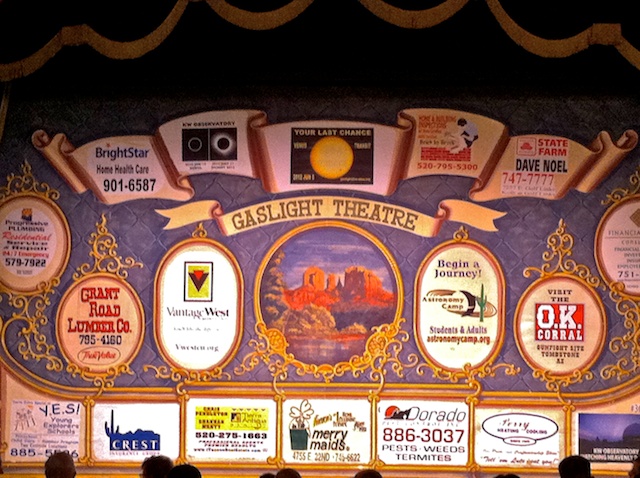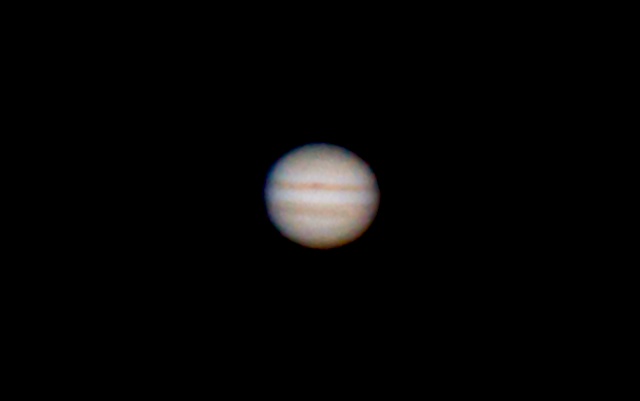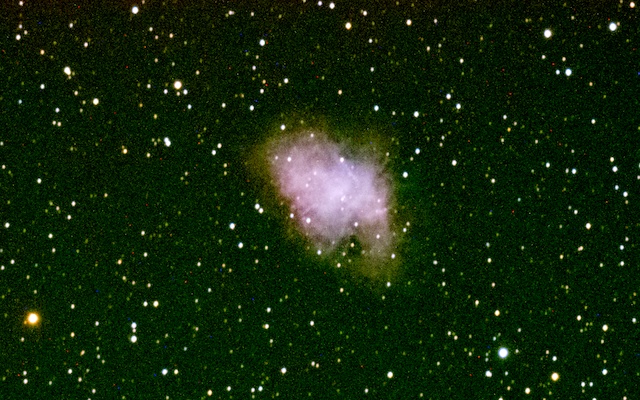
Jupiter, D7000 Crab Nebula, Spectroscopy, iPhone M42
Posted: 24 October 2011
On my previous report, I mentioned that seeing became increasing worse during the session. That must have been due to changing atmospheric conditions as clouds began showing up on Friday, 21 October. The amount increased from the south during the day and by sunset there were sufficient clouds around that I decided to skip opening the observatory. And Saturday night, we went to a play at a local theater. It was nice to see four astronomy related ads on the theater curtain.

The observatory was opened Sunday, 23 October, at 2028 MST, 72°F. 2033 MST: Jupiter viewed at 77X; 4 moons and a very large dark disturbance in the NEB near the central meridian were visible. Used 15mm, 9.7mm, 5.5mm, and then 9.7mm (206X) eyepiece with moon filter to observe the NEB disturbance. At 2050 MST, I took this image of Jupiter with the D7000 DSLR at prime focus of the 8" LX200-ACF, 1/200sec, ISO 800, cropped. I increased the saturation to bring out the disturbance, just left of central meridian in the NEB on top, and the Great Red Spot in the SEB, right of the central meridian.

I also took this image of Jupiter with the iPhone 4, afocal, 9mm eyepiece, MX-1 afocal adapter, cropped from a video frame:

The disturbance and the GRS are both visible in the iPhone image. I continued to observe Jupiter from 2117 MST to 2241 MST.
I then began getting ready for D7000 DSLR prime focus + Off-Axis Guider imaging of M1 (Crab Nebula). 2245 MST: viewed M1 at 77X, low in the east. Needed to wait a little bit for it to get higher in the sky. 2332 MST: Bahtinov Mask focus test on the star Aldebaran. Then to M1; I could faintly see it in the D7000 viewfinder. I located an excellent guidestar and did a 60 second, ISO 5000, framing test. It was OK. I then did 5, 10, and 15 minute guided exposures of M1 at ISO 5000. This is the 15 minute exposure, cropped:

Ended M1 imaging at 0028 MST. At 0036 MST, viewed M42 (Great Nebula in Orion) in 26mm eyepiece. Lovely view.
I then set up for D7000 spectroscopy imaging. Here is Castor A and B, taken at prime focus with the Star Analyser, 1/20sec, IS0 1000:
And here is Pollux, 1/30sec, ISO 1000:
0104 MST: back to M42. Added the focal reducer. Took this iPhone 4 image of M42, afocal 26mm eyepiece +focal reducer, "Slow Shutter" app (set for 30sec, EV+2.0):

Some nebulosity is just barely visible surrounding the Trapezium stars.
0130 MST: ended imaging and viewed M42 with 26mm eyepiece + focal reducer. I then tried for the Horsehead Nebula. I could see some very faint nebulosity but could not detect the Horsehead. I added the Hydrogen-Beta filter; still no luck seeing the Horsehead. Tried the 2" 30mm + focal reducer (no filter); no luck. Removed the focal reducer; no luck with either the 30mm or 26mm eyepieces. I have seen the Horsehead Nebula in the past with the 8" telescope so I know it can be done. I'll keep trying as Orion gets higher in the sky this winter.
0155 MST: took a final look at Jupiter and then began closing up.
Closed the observatory at 0211 MST, 68°F.
I received this email regarding my earlier Vega spectrum:
I thought it would be fun to put your spectra in my spectroscopy software. The result is in the attached video. More details here: www.rspec-astro.com. All the best, Tom
The video (1m38s) can be viewed by clicking the image:
Go to the previous report.
Return to the Cassiopeia Observatory Welcome Page.